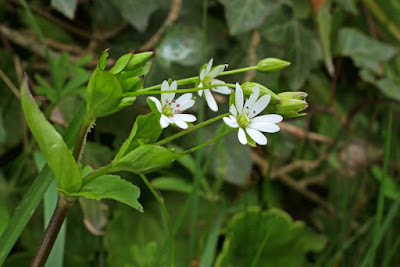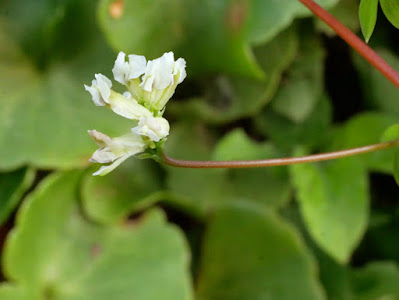The botanical County Recorder for Cornwall asked if I would mind surveying sites for Greater Chickweed (Stellaria neglecta) within my area. It's not a very exciting plant to look at, but it was one I had not seen before, so I agreed to give it a go.
I duly made a list of areas where they had been previously found (often decades before) and started off in the evenings for an hour or two to look for them. It made sense to record everything else I saw too, as not many botanists go down these country lanes very often to record!
As such, this blog is a compilation of interesting, pretty or rare plants I found along the way. This included some stunning insects such as this Orange-tip butterfly resting on Greater Stitchwort.
At this time of the year, many plants have leaves but no flowers. It's then a challenge to identify them from leaves alone. The one below, I kept seeing and worked out that it was Corn Parsley. Apparently this is common here in Cornwall. Common Valerian and Saw-wort are other examples I keep finding in leaf only.
Petroselinum segetum
Common Ramping Fumitory is very common along the lanes and its large flowers (11-13mm) and loose heads of flowers make it stand out. There are sub species for it, but I no longer try and work these out given that the experts believe they are more than likely varietal rather than actual subspecies. Time will tell I suppose.
Fumaria muralis
It didn't take long to find Greater Chickweed, and over the next couple of weeks, I found hundreds of them. So far, I have found them in all places where they used to be except one. That's offset by me finding a new site too. So good news locally for this species anyway.
Here it is, not terribly impressive but about twice the size of the usual Common Chickweed found in the street or field edges. Hairy sepals and pedicels are named var. neglecta and glabrous ones are var. elizabethae.
Stellaria neglecta var. elizabethae
Grasses is an area of botany where I struggle. Having said that, I can identify all the obvious ones and they are coming into flower fast now. This one with a compact spike of flowers is Meadow Foxtail.
Alopecurus pratensis
In north Cornwall, rivers and streams, brooks and rivulets abound, so many areas are permanently wet. A peek over a small bridge revealed these wonderful Marsh Marigolds growing in complete shade under trees around one such wet and boggy area. Although these are sold in garden centres, they are actually a native plant and are widespread where conditions are right for them.
Caltha palustris
Another wet loving species is Butterbur. Unfortunately, these ones I found at a strangely named place called Washaway, had gone to seed. I joked online that they were Cornish Lizard Orchids, which raised a few eyebrows. I might repeat that post on April 1st next year!
Petasites hybridus
There was an abundance of common wildflowers, turning country lanes into a riot of colour, such as these Primroses.
Primula vulgaris
Wild Garlic or Ramsons
Allium ursinum
Greater Stitchworts and Red Campion looking amazing.
Stellaria holostea and Silene dioica
Several trees are now also flowering. Here is one I've seen online many times, but until now, never seen in the wild. It's the fruits of an Elm. Which species I don't know, its taxonomy is very complicated with clones and hybrids making it all far from easy, thus I record all Elms as:
Ulmus
Along one lane, I found at least 30m of these Pink Purslanes along both road verges. The only habitation near was a working farm, with no farmhouse or other garden near, so I don't know how they arrived here.
Here's one in amongst the Greater Stitchworts that line most rural roads now.
Claytonia sibirica
Moschatel or Town Hall Clock, is a common plant in the ancient woodlands of Kent, but here in Cornwall, it is very rare, so I was both pleased and surprised to find a patch in flower by a road verge under planted Beech trees. I suspect they came with the trees inadvertantly when the trees were planted.
Adoxa moschatellina
You see some unusual things too, such as this post box with its knitted Easter themed hat on and in another village was a red phone box full of books to read and swap for free. All signs of a good community spirit, sadly lacking elsewhere.
Shining Cranesbill, abundant on verges, but mostly near villages or towns.
Geranium lucidum
A dried up muddy pudlle had Ivy leaved Water Crowfoot growing in it. Blotchy leaves shaped rather like Ivy and tiny flowers identified them.
Ranunculus hederaceus
Something that is odd is that Cornwall has retained its population of Bluebells despite losing most of its woodland. The species easily jumped onto Cornish walls (made of earth and stone) and colonised them along with new woodland too. So it great to find some large stands of them here too.
Hyacinthoides non-scripta
Several areas near me are home to Climbing Corydalis. I'd only ever seen this twice before, once at Dungeness and the other at Hothfield Heath,, both in Kent. But the flora is different here and this plant is pretty much all over the place here.
Ceratocapnos claviculata
Sisymbrium cheiri
I have found several Early Purple Orchids from their rosettes alone, but now they are coming into flower. They seem to be mostly small and unassuming and are loathe to open their flowers while the cold weather persists. They had better hurry up though, as the council mowers are already out and about in force. These ones escaped being mowed by about one foot!
Orchis mascula
Ficaria verna subspecies verna
So, I have had a good time exploring the lanes looking for this little plant and found lots to keep me interested. I hope you found it interesting too, though I apologise for it being a bit long. There was so much, I left out many finds too!
Stellaria neglecta var. neglecta
Take care
Dave































No comments:
Post a Comment
All comments are moderated before publication, so please don't bother spamming me, thank you. Genuine comments most welcome.